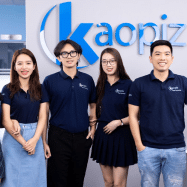NEWS


2024.02.02

2024.02.02
Utilizing ChatGPT for App Development: Successful in Fully Automatic App Development!
There is a conversational AI called "ChatGPT" that has garnered significant attention in the world. As it is widely used in various environments, many people are likely familiar with it. It has been featured in many media outlets too.
There are various ways to use ChatGPT, and currently, it is possible to automatically develop apps. In an era where even beginners can easily develop apps, let's understand app development using ChatGPT.



Table of Contents
- 1. Understanding App Development with ChatGPT
- 2. App Development Process with ChatGPT
- 3. Examples of Apps Developable with ChatGPT
- 4. Recommended Tools for App Development Using ChatGPT
- 5. Current Limitations in App Development with ChatGPT
- 6. Conclusion
1. Understanding App Development with ChatGPT
Some may find it challenging to imagine what it means to develop an app using ChatGPT. Let's start by explaining the basics.
1.1. Overview of ChatGPT
ChatGPT refers to the conversational AI service developed and provided by OpenAI. While there are various types of AIs, ChatGPT stands out for its ability to engage in communication much like a conversation with a human. It can interact bidirectionally, making it suitable for handling complex tasks such as app development. However, it is primarily a comprehensive AI service, with applications extending beyond app development. It is commonly utilized for tasks like generating text content and automatically processing data.1.2. The Era of Fully Automatic App Creation
Given ChatGPT's extensive learning capabilities, it can also adapt to programming tasks. By conveying the desired features of the application and the programming language needed, ChatGPT can generate source code. For instance, if you request, "I want to calculate time differences in Python," it interprets the request and presents the corresponding source code. It's worth noting that instead of directly conversing with ChatGPT for fully automated programming, it's also possible to use specialized applications. Later, we will introduce tools specifically designed for fully automatic app development.2. App Development Process with ChatGPT
When developing an app using ChatGPT, the overall process follows a specific sequence. The steps involved are as follows.
2.1. Design
Before developing the app, a design phase is essential. This involves specifying what the app should do, and this information needs to be communicated to ChatGPT. For instance, details such as the app's purpose, how it will be used, and specific requirements should be conveyed. Since ChatGPT is interactive, the design process can be guided through questions and answers. However, designing an app while interacting with ChatGPT might be challenging, especially for complex apps. If you're considering developing a sophisticated app, continuous interaction with ChatGPT might become burdensome. In such cases, if you want to emphasize the design aspect, consider consulting with our company, Kaopiz. Our app development professionals can assist in designing the optimal app based on your challenges and requirements.2.2. Environment Setup
To run the app, an execution environment must be set up. Typically, engineers handle these tasks, but when developing an app using ChatGPT, it might be provided or guided by ChatGPT itself. Additionally, using tools that leverage ChatGPT for app development can eliminate the need for manual environment setup. These tools can automatically generate source code and deploy it to the execution environment based on descriptions provided through a web browser, for example.2.3. Implementation
Once the necessary environment is in place, you proceed to the implementation phase, which mainly involves programming. While human developers include a testing phase, ChatGPT, when generating source code automatically, does not include testing. It provides source code based on the design discussed earlier, considering the programming language specified. However, it's important to note that the quality of the generated source code by ChatGPT may vary. Although it might create code that functions correctly, certain aspects like "exception handling" might be missing. Unforeseen events may not be handled appropriately. Additionally, since ChatGPT generates code based on learned data, there could be copyright-related issues. To address these issues, human intervention is necessary to write high-quality source code as quickly as possible. For example, by outsourcing to Kaopiz, you can achieve "low-cost" and "high-quality" app development through offshore development, which is often more cost-effective than commissioning development in Japan.2.4. Execution
Once the app development is complete, the next step is execution. Confirm whether the developed source code can be placed in the execution environment and launched successfully. For programming languages that require compilation, like Java, it may be necessary to compile the code generated by ChatGPT. After successful deployment and execution, ensure that the app functions as intended according to the design. If any unexpected behaviors occur, you may need to re-engage with ChatGPT. While ChatGPT can automate or semi-automate app development, it may not catch implementation errors until the end of the process.3. Examples of Apps Development with ChatGPT
There are several types of apps that can be developed using ChatGPT. Let's introduce specific examples of the types of apps that can be developed.
3.1. Web Apps
Web apps, applications accessed and used through a web browser, are easily developed using ChatGPT. Examples include search forms on platforms like Google, which are web apps. ChatGPT itself, used for app development, is also a web app. Numerous apps commonly used for work are also developed in this category.3.2. Mobile Apps
For simple mobile apps, ChatGPT can handle everything from design to implementation. Whether it's a web application or one that requires compilation, ChatGPT can automatically generate the code. With proper interaction during the design stage, you can receive a reasonably quality implementation. However, for mobile apps that require compilation, there may be challenges in proper implementation. ChatGPT may struggle with tasks that involve file splitting, making the generation process prone to issues.3.3. PC Tools
Like mobile apps, simple PC applications can also be implemented using ChatGPT. Think of desktop applications that run on Windows, capable of handling basic input and data processing. However, for PC applications, file splitting is common, and ChatGPT is not particularly adept at this. Especially for implementations with numerous classes and extensive use of object-oriented programming, ChatGPT may not be suitable. It can handle within the scope of simpler implementations without requiring extensive file handling.4. Recommended Tools for App Development Using ChatGPT
Several tools utilizing ChatGPT for app development have been developed and made available. Here are two specific tools:4.1. GPT Engineer: Wide Range of App Development
Accessed through a web browser, GPT Engineer is a tool that develops apps using ChatGPT. It provides an input form where you can enter the necessary details for the app, and it automatically generates a web app. Not only does it generate a web app, but it also allows for immediate execution. Without the need to set up your environment, it automates the entire process from development to execution.4.2. GPTApp: Web Application Development
GPTApp is another tool that develops apps using ChatGPT and can be accessed through a web browser. Similar to GPT Engineer, it provides an input form for specifying the details of the app, automatically generating a web app. Like GPT Engineer, it doesn't just generate a web app but also allows for immediate execution. It streamlines the entire process from development to execution without the need for manual environment setup.5. Current Limitations in App Development with ChatGPT
As explained, using ChatGPT and tools like GPT Engineer can enhance the efficiency of app development, even enabling fully automatic development. However, it's crucial to acknowledge that ChatGPT has limitations when it comes to AI-assisted app development. For instance, generating code for complex processes with perfect understanding is nearly impossible. To address these limitations, human involvement is still required, particularly in designing, implementing, and testing. It's essential to recognize that while AI, represented by tools like ChatGPT, can streamline app development, it has its constraints.6. Conclusion
Utilizing conversational AI like ChatGPT enables fully automated app development. Tools integrated with ChatGPT allow for code generation by simply conveying the overview of the desired app. Alternatively, direct interaction with ChatGPT throughout the development process is also possible. While AI has evolved to make app development more accessible, there are still inherent challenges. For instance, dealing with complex designs remains a weakness. Recognizing the limits of app development with ChatGPT, if you aim for high-quality app development, human intervention is necessary. Developing in Western countries can be expensive, but utilizing offshore development, such as Kaopiz, can offer cost-effective and high-quality system development. Consider entrusting your app development to professional engineers rather than relying solely on AI like ChatGPT.Contact Us
Most read news

Informative Column
Transforming Elections result with E-Voting platform
24.11.05
Discover how e-voting technology can shape future US elections with Kaopiz’s expertise in secure, efficient systems.

Informative Column
Outsource AI Development with Top Engineers & Companies
24.10.26
Accelerate innovation with AI outsourcing. Access top AI engineers, leading companies, and proven development models for efficient solutions.

Informative Column
IT Outsourcing Trends: Key Insights Shaping 2025
24.10.24
Stay ahead with the latest IT outsourcing trends, including cloud adoption, AI, and regionalization strategies for global competitiveness in 2025.


